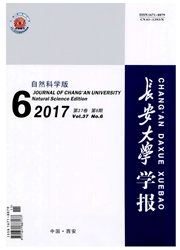

 中文摘要:
中文摘要:
基于道路实测分析了不同路段上车辆排放的变化,并对MOBILE和IVE这2个中观尾气模型进行参数标定后,通过比较实测值和预测值分析了这2个模型在中国的适用性。研究结果表明:行驶状况是影响路上车辆实时排放的一个重要因素,次干路及以下等级路段上车辆行驶工况更为复杂多变,容易出现高污染排放;MOBILE和IVE这2个模型的预测值与实测值在整体变化趋势上具有较好的一致性,但均存在不同程度的低估,其中MOBILE对NOx和HC预测误差较大,大部分路段误差超过30%,CO预测精度稍好,超过一半路段误差低于30%;IVE模型对CO预测精度与MOBILE模型基本持平,而对NOx和HC预测精度大大高于MOBILE模型,大部分路段误差低于15%。IVE模型引入机动车比功率(VSP)和发动机负荷(ES)代替平均速度来反映车辆行驶对排放的影响,更适合应用于中国针对路段进行的中观层次机动车排放污染评估。
 英文摘要:
英文摘要:
Vehicle emissions on various road segments were analyzed based on real road test. Then the parameters in two meso-level emission models of MOBILE and IVE were calibrated, and their suitability in China was analyzed by comparing actual with model-predicted emissions. The results show that driving condition is one important influencing factor for vehicle's real time emissions, and due to complicated driving conditions on road segments that below minor arterial grade, vehicles are more likely to produce high emissions. Furthermore, the predicted results indicate that both of two models' predicted values have good consistency with actual values on the overall trend, but they underestimate vehicle actual emissions under different degrees. The prediction errors of NOx and HC from MOBILE are high, and the relative errors in most of road segments are larger than 30 %. The prediction accuracy of CO from MOBILE is slightly better, and the relative errors on more than half road segments are less than 30%. The prediction accuracy of CO from IVE is similar to that from MOBILE, but the prediction accuracy of NOy and HC are much higher than that from MOBILE, and the relative errors on most of road segments are less than 15%. Since the IVE introduces two parameters of the vehicle specific power (VSP) and engine stress (ES), instead of average speed to reflect the impacts of driving condition on vehicle emissions, it is more suitable for China to evaluate meso-level vehicle emissions toward road segments. 4 tabs, 9 figs, 25 refs.
 同期刊论文项目
同期刊论文项目
 同项目期刊论文
同项目期刊论文
 期刊信息
期刊信息
